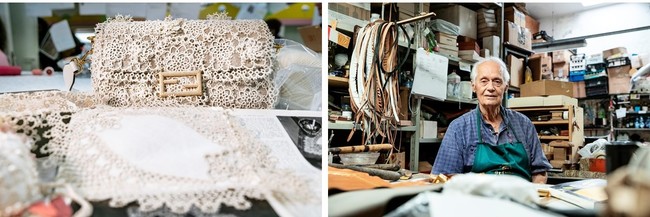
FENDI, the luxury brand renowned in Rome, Italy, is pleased to announce "Hand in Hand," a grassroots partnership project with artisans across Italy, celebrating its longstanding appreciation for Italian handcraft. Beginning with the legendary "Baguette" bag, designed by Creative Director Silvia Venturini Fendi in 1997, this unprecedented project showcases the time-honored techniques of applied arts specialists.
Drawing on the skills of artisans across Italy, FENDI continues its long history of reinterpreting the iconic shape of its iconic "Baguette" bag. The "Hand in Hand" project reinterpreted the Baguette using regional craftsmanship, inviting a diverse group of ateliers and workshops to transform the handbag's traditional structure into a genuine art object. Each Baguette is limited to an edition of 20, and each bag is engraved with the name and address of the atelier, as well as the gold "FENDI Hand in Hand" logo, on the inside pocket.
"I'm working on special projects with selected artisans from different regions of Italy. The first piece was the leather Baguette bag that was shown on the Fall/Winter 2020-21 runway. It was made in Tuscany by one man who handcrafts each small leather item in small batches. He makes everything himself. It's made from very natural vegetal leather and there are no stitches, just glue. "My current goal is to explore all the Italian regions and select the best artisans still working today, and then to expand the project globally." - Silvia Fendi.
The name "Hand in Hand" animates this unique collaboration, representing the encounter between the local artisan's hands and Fendi's own, bringing together the talents and techniques of ancient, highly valued handcraftsmanship through a series of one-of-a-kind creations. Beyond the creation of artisanal Fendi products, this project is also an important step towards establishing a strong human network to preserve and transmit the rare skills, creativity, and savoir-faire of local artisans throughout Italy.
Debuting as Look No. 13 on the Fendi Fall/Winter 2020-21 Women's Collection runway, the "Hand in Hand" partnership takes us to Tuscany. Atelier Peroni in Florence has been crafting small leather items from vegetable-tanned leather, a tradition typical of the region. Since 1956, this traditional Florentine artistic method, known as "cuoio artistico fiorentino," has been practiced. Now in its third generation, the family business has specialized in crafting robust structures, such as the timeless "tacco" coin purse. Each baguette, with its lustrous, diagonal frame, is cut and shaped from a single piece of leather—completely unlined or stitched. Finished in dark chocolate brown, the baguette piece also features the signature FF buckle, encased in leather for a seamless monochrome effect, underscoring the unique nature of Peroni's handmade leathercraft. It involves a lengthy, handcrafted process, first wetting the leather and then placing it on a wooden mold to achieve the desired shape. Peroni artisans are like leather sculptors.
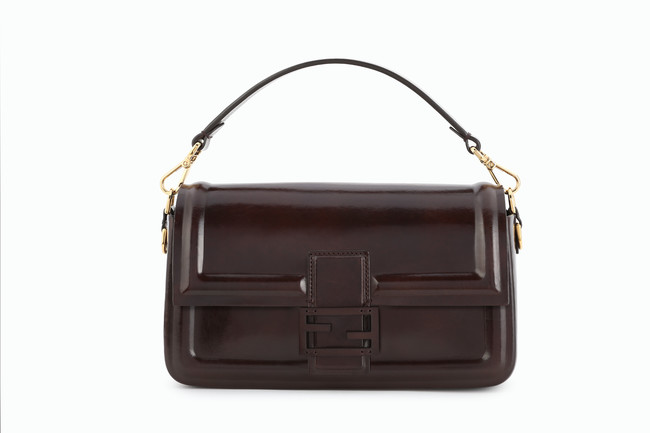 Florence_Peroni
Florence_PeroniThe "Hand in Hand" partnership next heads west to the island of Sardinia, where the focus shifts from leather to textile arts. In the hilltop village of Ulassai, the Su Marmuri women's cooperative has been dedicated to hand-weaving tapestries since 1971, preserving local traditions. Using manual looms, artisans weave natural fiber threads to create intricate dotted reliefs. This hand-weaving technique is affectionately called pibiones, meaning "grape" in the local Sardinian dialect. For Fendi, weavers in Smarmuri created a black-and-white diagonal stripe motif for the body of the Baguette, with the FF logo pattern woven into the inside. To showcase the beauty of both sides of the Pibiones weave, the soft Baguette is finished unlined and adorned with long shearling fur on each side.
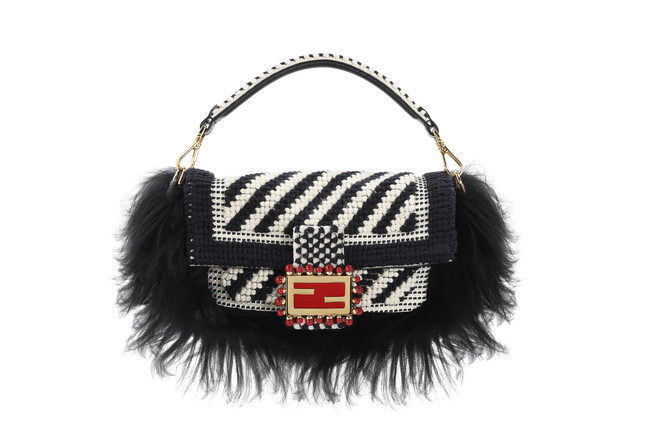 Sardinia_Smarmuri
Sardinia_SmarmuriOur next "Hand in Hand" partnership explores the archives of Luigi Bevilacqua, a jacquard artisan in the heart of Venice, in the Veneto region, who creates luxurious Venetian textiles drawing on five centuries of family experience. Handwoven on 18th-century looms, Bevilacqua's Soprarizzio "Over the Curl" silk and cotton velvet is one of the most time-consuming "hand-in-hand" projects. Inspired by the repertoire of ancient Venice, the opulent floral brocade motifs are cut millimeter by millimeter and woven by artisans, who can only produce a few centimeters of fabric per day. Lined in powder pink silk, the Baguette evokes the Venetian spirit and the colorful history of the palace, its faded yet radiant beauty. The baguette bag is further enriched by a jasper-engraved FF buckle and handle with lizard detailing, and a knotted interlaced satin strap.
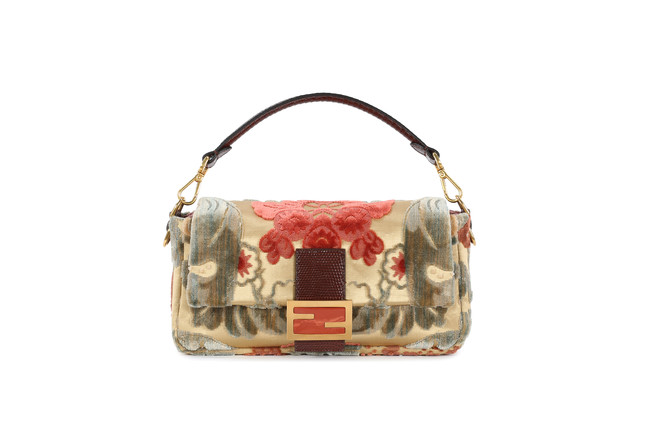 Veneto_Bevilacqua
Veneto_Bevilacqua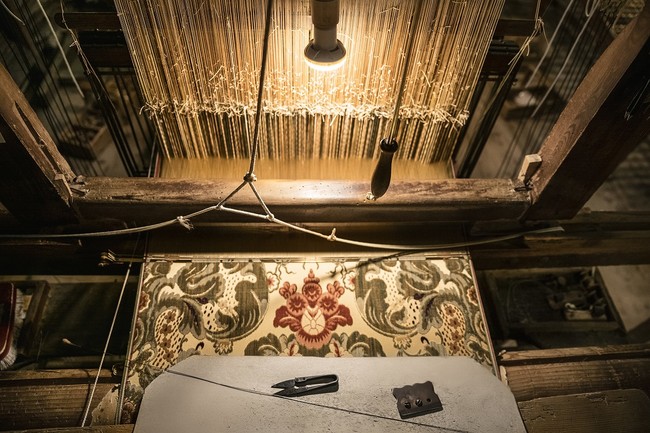 Marche_Bottega Intreccio
Marche_Bottega IntreccioHeading south to Puglia, this "Hand in Hand" partnership celebrates a long-standing collaboration with Dodino lacemakers, based in the village of Nardò. His lace designs, made of delicate loops and knots, are crafted by weaving thread onto wooden shuttles, creating concentric floral designs using the traditional Apulian technique known as chiacchierino. Chiacchierino evokes the joyful, conversational nature of artisans at work. Laid against a padded cotton and linen base, the Chiacchierino lace appears to float in a 3D floral cloud on the surface of the baguette, which is secured with a special FF buckle adorned with tiny pearls. A staple of the central Italian region of Marche, the art of weaving wicker, leather, and cord dates back to the Renaissance and has been passed down through generations at Bottega Intreccio. The "Hand in Hand" project here celebrates the local custom of weaving with willow branches, with artisans weaving branches specifically for Fendi. Willow trees are native to the Marche region, resulting in a limited harvest each spring. To create these baguettes, artisans hand-weave them around a metal frame, soaking the willow for several days in water to enhance its flexibility. The resulting baguettes showcase the natural texture and tones of the pliant wood, accented by an woven willow motif, inspired by the baskets of local fishermen, and finished with vegetable leather details.
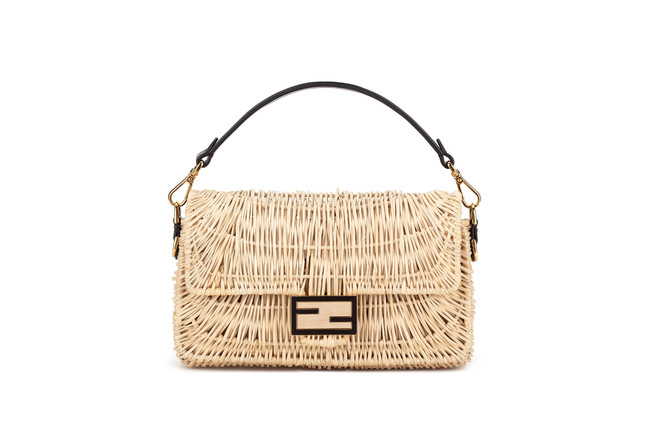 Umbria_Giuditta Brozzetti
Umbria_Giuditta Brozzetti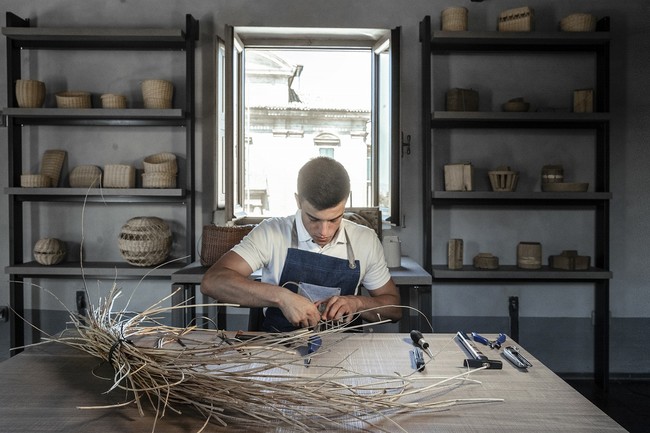
Heading to Umbria, the luxurious handwoven fabrics of the city of Perugia are the focus of the next "Hand in Hand" collaboration. This collection celebrates the highly decorative and historic patterns created by Giuditta Brozzetti since 1921, one of the first examples of her initiative for female entrepreneurship. The atelier, with its own laboratory, offers work opportunities to local women who once trained in weaving within Franciscan convents to produce wedding linens. Now in its fourth generation, the family business produces authentic handwoven fabrics inspired by medieval designs using antique 19th-century looms. For Baguette, the Giuditta Brozzetti store, now run by the brothers' granddaughter, Marta, has recreated a historic weaving motif featuring horses, peacocks, unicorns, and doves from classical mythology in a two-tone scroll motif in bright royal blue against a neutral background. In the past, this blue was considered a highly aristocratic color, due to the rare indigo dye imported from Southeast Asia. This royal blue allows the bag to shine with its inherent luxury. The bag is finished with handmade macramé lace, inspired by the ancient trimmings found on medieval textiles.
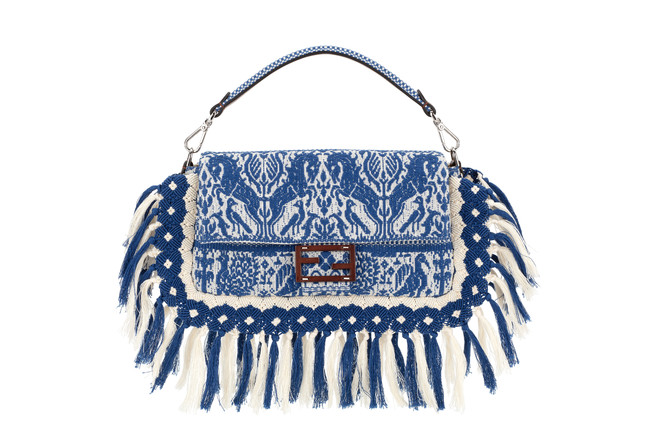 Molise_GC Correddi
Molise_GC CorreddiKnown as the lace town of Isernia, Isernia is located in the Molise region on Italy's east coast (near the heel of the Italian boot). Made from delicate ivory thread, Isernia bobbin lace is prized worldwide for its flat, geometric patterns and ultra-light spirals made from tiny wooden bobbins, a tracery pattern held on a cylindrical, cushioned base. Legend has it that Benedictine nuns brought the tradition from Spain in the early 16th century, passing on the technique to the Sisters of Santa Maria delle Monache. This Fendi "Hand in Hand" project, realized by lace specialists in collaboration with GC Corredi lace shop, features nappa leather baguettes overlaid with panels of Isernia lacework in pale neutral colors.
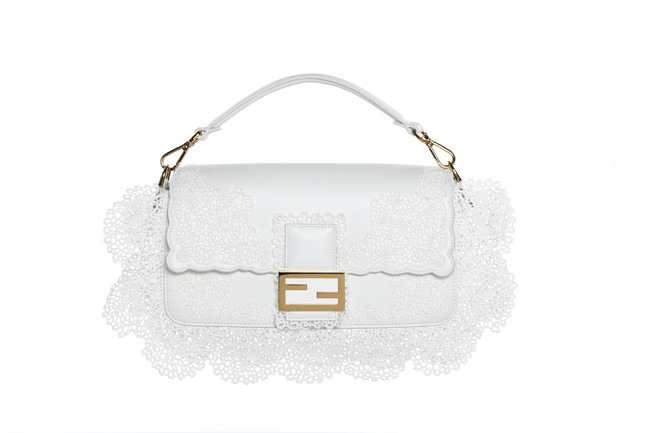 Calabria_Fabbrica Tessile Bossio
Calabria_Fabbrica Tessile Bossio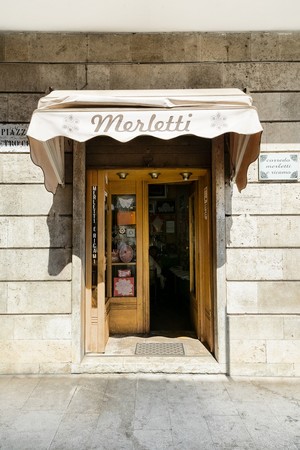
Along the coast of Cosenza in Calabria, the ancient art of weaving "ginestra," or broom fiber, has been passed down through generations. It's a completely handcrafted process with zero pollution emissions, requiring no electricity, complex machinery or chemicals. Harvested throughout the summer, the hardy shrubs are hand-processed into a cool fiber material that is woven into natural panels to create the plant-based baguettes – in collaboration with Fabbrica Tessile Bossio. The baguettes feature designs inspired by local traditional motifs, and the iconic FF logo pattern is dyed with natural, plant-based dyes. Long fringes made from broom thread, all hand-tied, adorn both sides of the bag.
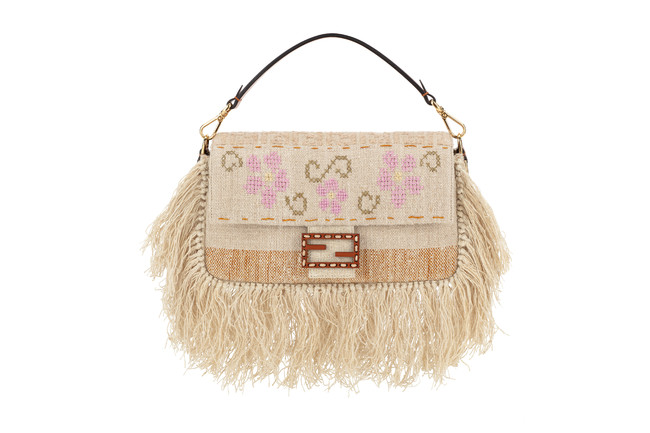 Lazio - Massimo Maria Melis
Lazio - Massimo Maria Melis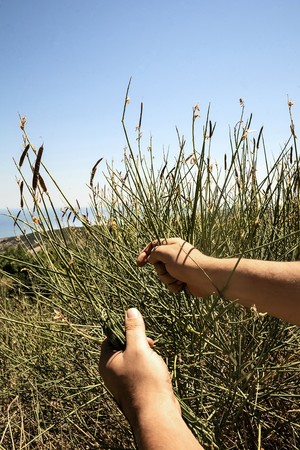
In Rome, FENDI's hometown in the Lazio region, the rich historical techniques of marble marquetry and silver and goldsmithing are still alive and well under the tutelage of master jeweller Massimo Maria Melis. The pieces are now combined into a single piece by Melis. Since 1982, from its renowned atelier and boutique on Via Dell'Orso in the heart of Rome, Melis has garnered international acclaim for its intricate Etruscan and Roman-style jewelry incorporating ancient coins, polychrome glass, and marble. Now, for the FENDI "Hand in Hand" project, a precious baguette bag marries FENDI's leather techniques with the splendor of Melis's gold-plated silver appliqué "bezel," crafted using the lost-wax technique. It also features an extremely rare hand-carved marble inlay—a rare stone extracted from a now-closed quarry. The bezel is crafted using a special Roman technique called "granulatura," which creates a groove-like motif around the bezel. The front of this baguette is decorated with two precious original bronze coins depicting Roman emperors from the Imperial era.
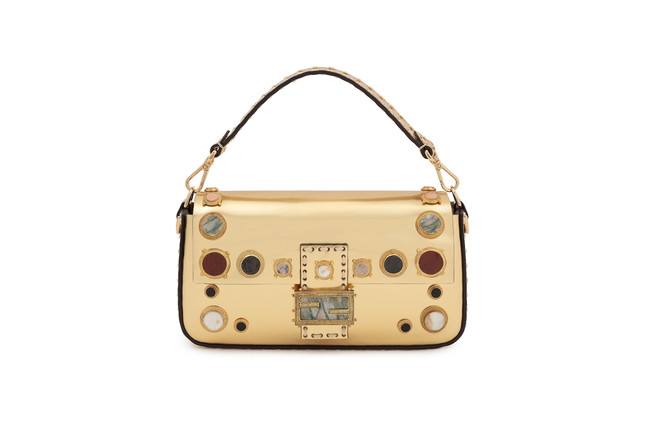 Abruzzo_Simona Iannini
Abruzzo_Simona IanniniMoving to the Abruzzo region, for its next "Hand in Hand" collaboration, FENDI commissioned artisan Simona Iannini from the city of L'Aquila to create a baguette made entirely of "tombolo aquilano" lace. This ancient and meticulous technique dates back to the 1400s, when local women meticulously recreated projects designed by various architects. It became a popular art form, often practiced by Benedictine nuns. The workmanship of tombolo aquilano is very different from other lacemaking techniques. As artisans interweave the individual threads to create the desired pattern, they never cut, sew, or knot the threads—resulting in a baguette that resembles a precious jewel. This baguette features olive tree details, inspired by the fine wooden bobbins used to create this unique finish. Crafted from interlaced linen thread, it forms a delicate net design with a small FF logo and a lace strap. The bag itself requires over 100 hours of work. Once completed, the unlined lace is starched using ancient techniques to add firmness and dry for three days on a wooden mold.
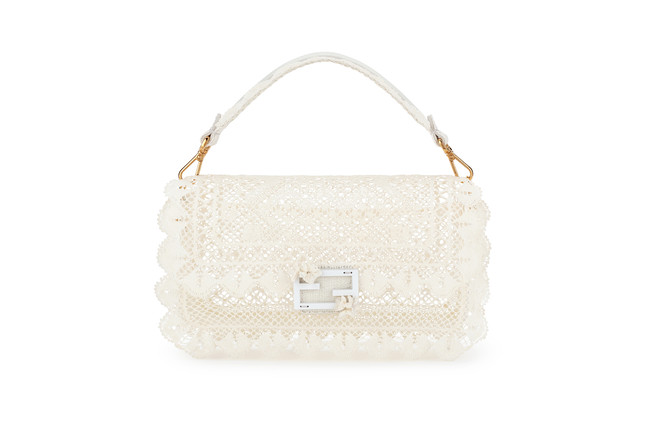
In Trapani, Sicily, master goldsmith Platimiro Fiorenza is recognized by UNESCO as a Living Living National Treasure. A jeweler and goldsmith, Platimiro specializes in the art of red coral, preserving a local art form dating back to the 12th century. Handcrafted in his atelier, the baguette features a unique facade made of red coral pieces, making it one of the most precious "Hand in Hand" project pieces. The bag is crafted from a silver, hardened laminate panel, cut into a geometric pattern and featuring coral inlays using the retroincasso technique, reminiscent of a treasure chest.
The "Hand in Hand" initiative is an important step in Fendi's commitment to artisans across Italy, those who continue to give life to traditional production techniques. These regional workshops and ateliers are at the heart of the "Made in Italy" movement. Fendi believes it is now time to foster the preservation of ancient, handmade workmanship on an unprecedented international scale. Together, we can celebrate unique Italian creativity and preserve ancient crafts for the future.
Click here for details on company press releases
The press releases published in this article have been provided by PR TIMES Inc. and are published in their original form. FASHION HEADLINE does not recommend the products or services published, nor does it guarantee the content of the press releases. For inquiries regarding the content published, please contact PR TIMES Inc. (https://prtimes.jp/) directly.
















